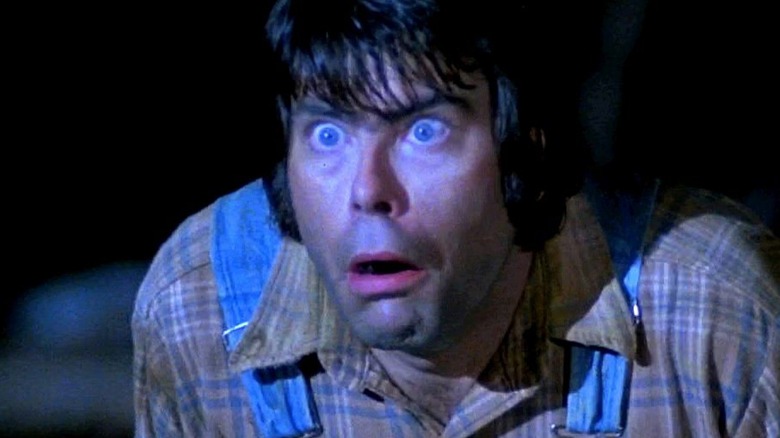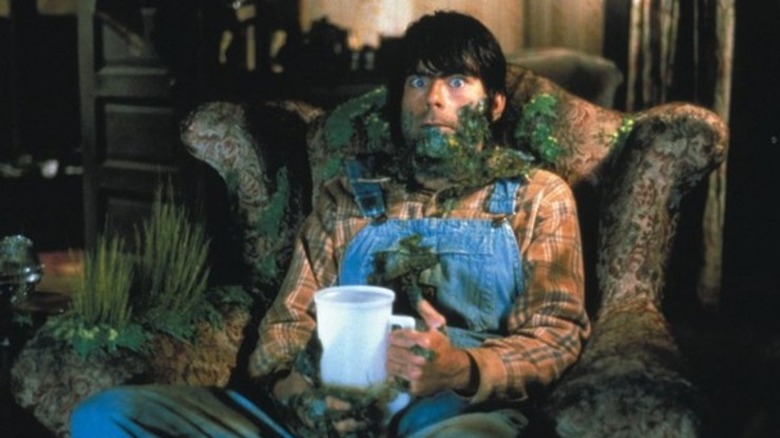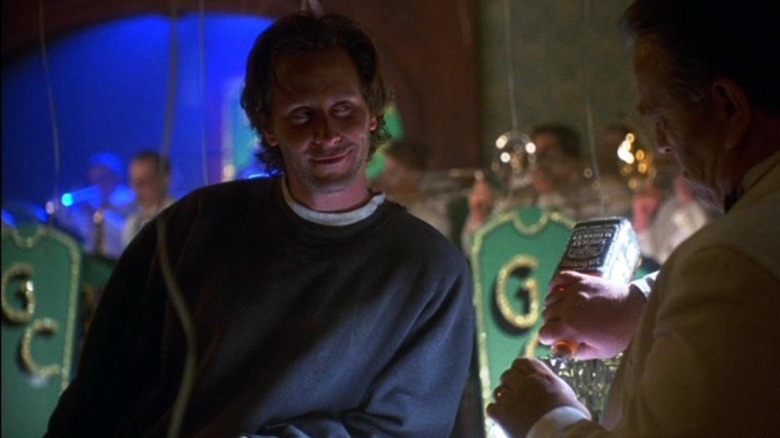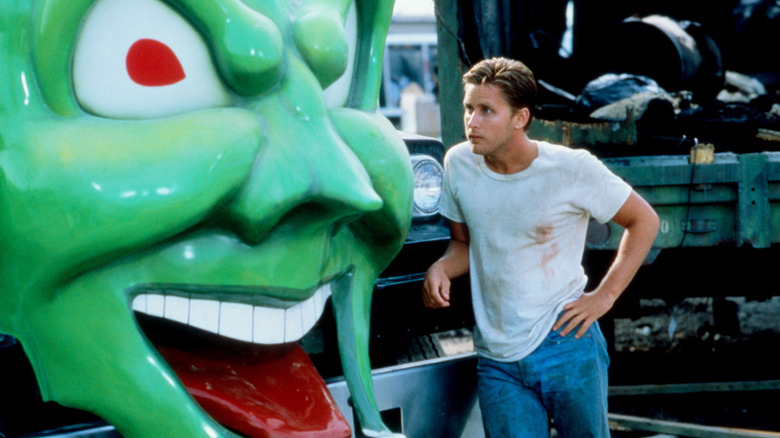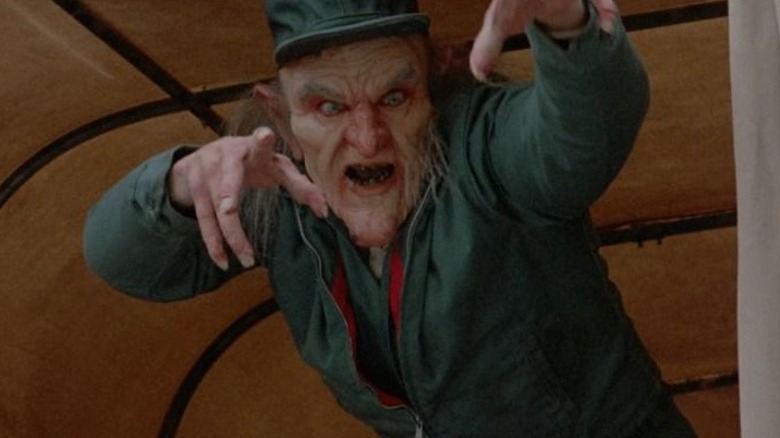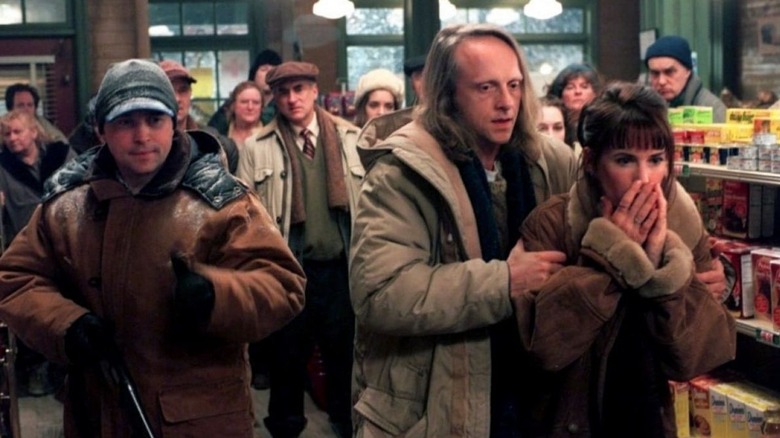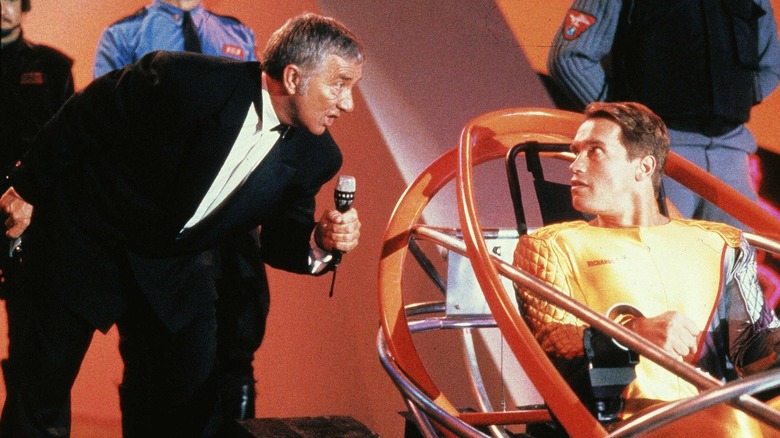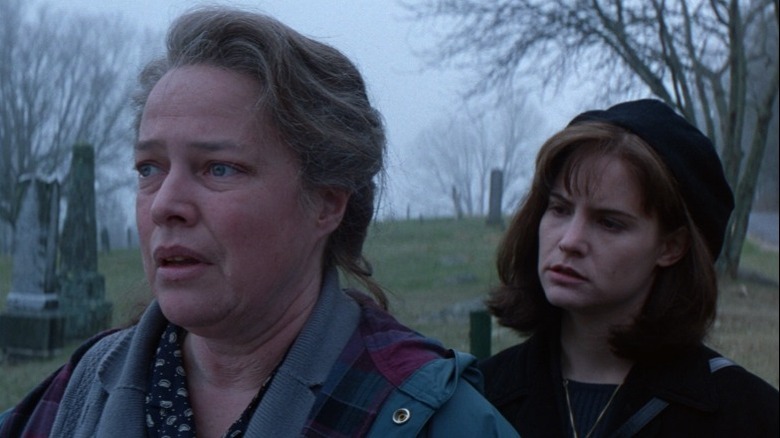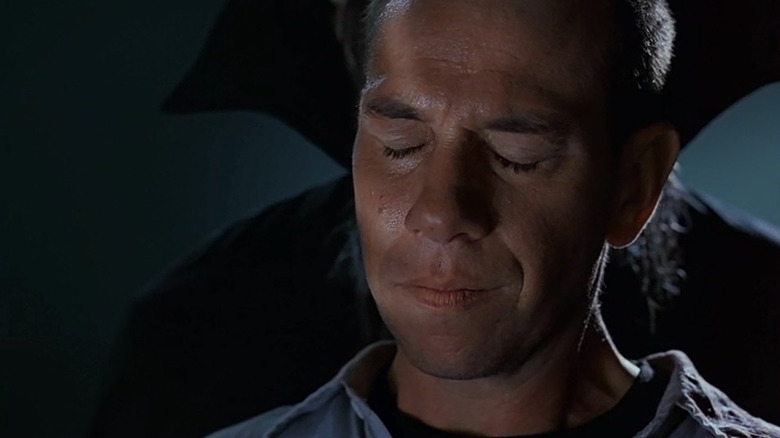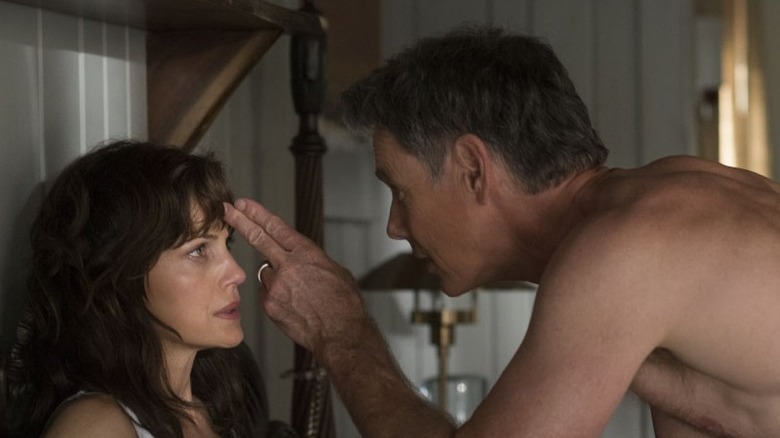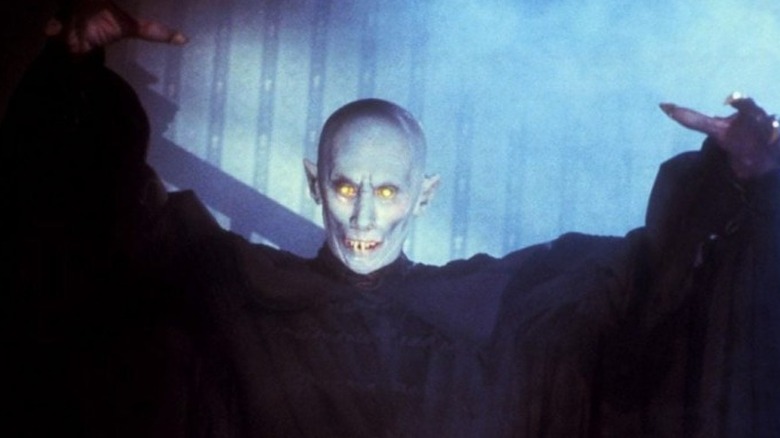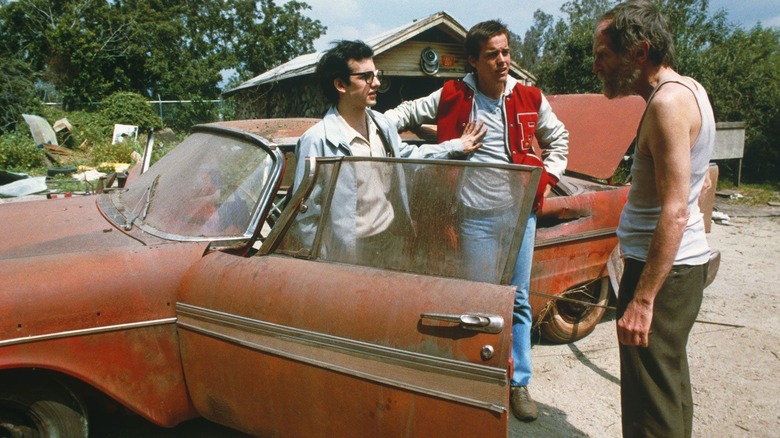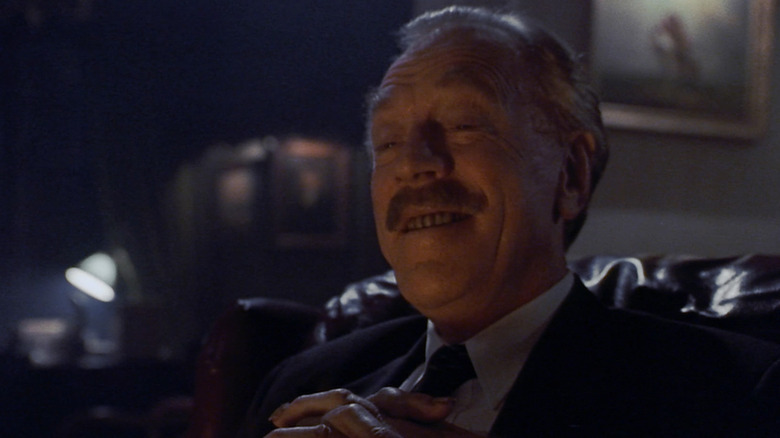12 Underrated Stephen King Movies You Should Check Out
Not all Stephen King movies are created equal. King's massive catalog of frights has made for exciting film adaptations ever since Brian de Palma gave us "Carrie" in 1976. However, "The Shining" might be best remembered for King's criticisms of the film. Those who remember 1979's "Salem's Lot" miniseries might have found themselves asking, "Why is the vampire blue?" Does 2017's "It" really have a scarier Pennywise the Dancing Clown than the 1990 remake?
The most successful King adaptations tend to stray from the source material, which isn't always a bad thing. King is a master storyteller, but his gifts don't automatically translate to the screen. In fact, creative license often makes the movies based on his work — "Carrie" and "The Shining" in particular — better than they would have been had they followed the text faithfully.
Because the adaptation process is imperfect, some King movies succeed where others fail. Others get lost in limbo, solidifying their places as cult favorites. This author has been tasked with giving some love to those underrated Stephen King movies, so let's do this!
Creepshow
For "Creepshow," King and fellow horror legend George A. Romero adapted two of King's short stories, as well as three original scripts, into a love letter to the days the author spent reading EC comics as a kid. Divided into five vignettes, "Creepshow" stars Adrienne Barbeau, Hal Holbrook, Leslie Nielsen, and King himself.
On its own, "Creepshow" might not count as underrated, but I don't think each individual segment gets the love it deserves. The opening story, "Father's Day," delivers over-the-top camp commentary on how the wealthy live. "The Lonesome Death of Jordy Verrill" finds some sadness before unleashing its frights. Nielsen's twisted turn in "Something to Tide You Over" is a great showcase for the actor's range, and "They're Creeping Up on You!" is what made me first realize that bugs terrify me.
Among all of these excellent moments, the fourth segment, "The Crate," tends to get lost in the shuffle. In "The Crate," Barbeau and Holbrook play Wilma and Henry, an unhappily married couple working in academia. Wilma is brassy and merciless, belittling the meek Henry at every turn. In many ways, they're like Martha and George in "Who's Afraid of Virginia Woolf?"
But hey, isn't this a horror story? Sure enough, while this segment has plenty of petty domestic squabbles, it also has a mysterious crate that's hidden under a university staircase. When Henry learns that an unidentified monster lives in that crate, he realizes that it could solve a lot of his problems. What I love about "The Crate" is that it's the people who are the actual monsters, and that the creature trapped in the crate is merely an accessory to some very human crimes.
The Shining
Seventeen years after Kubrick first brought "The Shining" to theaters, a remake arrived featuring a screenplay by King himself. 1997's "The Shining" was a three-part miniseries that stuck more closely to the source material in ways that I found jarring as a first-time viewer. At the time, I considered Kubrick's film the master text, even though I hadn't yet read the novel. As a result, I blamed some small changes on the miniseries, rather than my own stupidity: Wendy is blond, Jack attacks Hallorann with a croquet mallet instead of an ax, there aren't any twins, and so on.
However, while Kubrick's film is a classic on its own, this version of "The Shining" is essential viewing both for those who love the book and also for those who are curious about what King was trying to accomplish with the story. What I love about King's early work is that his characters have open conversations about alcoholism long before he got sober himself, something that comes out brilliantly in his memoir, "On Writing."
One problem with the miniseries is that it looks and feels like it was made for TV. I think that means it's due for an upgrade. Somewhere, Mike Flanagan is probably trying to make that very thing happen. His "The Shining" sequel, "Doctor Sleep," adroitly combines both the original book and Kubrick's film, so why shouldn't he get a chance to remake this story for the big (or small) screen?
Maximum Overdrive
In theory, "Maximum Overdrive" is a terrible movie. All the technology we rely on rebels, and we, the dumb humans, become helpless victims. What is this, the Disney Channel's "Smart House"? No, this is Stephen King doing sci-fi camp, a sub-genre I didn't even know existed. The author explained in Tony Magistrale's "Hollywood's Stephen King" that his excessive drug use at the time didn't help matters. Appropriately enough, when you watch the film, you do get the sense that it was made by a bunch of drugged-out people who liked cars and heavy metal.
Still, I can't help but love this road-trip-style horror flick. Directed by King himself, "Maximum Overdrive" has a fun cast that includes Emilio Estevez and Pat Hingle. Not every short story should be adapted into a feature-length film (this one is based on King's "Trucks," which was first published in the magazine "Cavalier"). Still, everyone should watch "Maximum Overdrive" at least once. I didn't like it on my first viewing because I expected a scary Stephen King story. On my second, I knew that it was garbage, and that made me enjoy this midnight movie much more.
Creepshow 2
The follow-up to "Creepshow" was not met with the same level of adoration as its predecessor. The Los Angeles Times called it "as exciting as leftovers," and it wasn't wrong. This sequel features three vignettes, and while I find them all to be pretty scary, they lack the rich characters of the first installment. There is no Leslie Nielsen as a vengeful rich dude, no Viveca Lindfors as crazy Aunt Bedelia, and no E.G. Marshall as an evil germaphobe. It cuts out the 1950s camp sensibility, and replaces it with the kinds of traditional scares we've come to expect from '80s films.
Part of the reason why I think this film was unsuccessful on release is that it leans towards realism instead of fantasy. Some might argue that a pond creature that hunts teenagers isn't particularly grounded, but I think "The Raft" is a pointed commentary on how humans treat bodies of water, and what might happen if we don't respect them.
And "The Raft" is what I'd really like to talk about. In it, four teenagers go swimming in a pond in the middle of nowhere, only to be hunted by a creature that resembles an oil slick. Few things in my life have scared me as much as this sequence. I think about it every time I get in the water, even if it's just a hot tub. "The Raft" masterfully gets under your skin, favoring chills over ick in a way that I can't gush about enough. Some people credit "Jaws" with their fear of water, but that just means they haven't seen "Creepshow 2."
Storm of the Century
"Give me what I want, and I'll go away," says Andre Linoge, the mysterious stranger who arrives on a small island in Maine just before a storm hits. He repeats the line throughout the four-hour miniseries, and with each delivery, it becomes more menacing. What I love about King's dialogue is how he uses repetition to his advantage. Linoge is a simple adversary. He looks like a plain man, but he's one of King's scariest creations, and I don't think he gets enough credit; as a society, we spend way too much time talking about Pennywise.
What sets "Storm of the Century" apart from the other films on this list is that it's not actually an adaptation. King wrote it specifically for television. Therefore, it doesn't fall victim to some of the traps of a traditional King film. He structured the story with commercial breaks in mind! He had a budget for props! He had to conform to the network's content standards! This is a big deal. Novelists don't usually write with a budget in mind, but the screenplay for "Storm of the Century" shows that King can create something that's both really scary and also easy to film.
"Storm of the Century" masterfully blends King's biggest strengths: small town narratives and simple scares. It's also a great homage to Shirley Jackson, particularly the ridiculous climax, in which the citizens draw stones to determine which child to give to the demon. I haven't seen "Storm of the Century" since its initial broadcast in 1999. Will it ever be available for digital consumption? I hope so.
The Running Man
On "Fear Factor," contestants climb into coffins with spiders. On "Survivor," castaways turn on each other for peanut butter. And on "Keeping up with the Kardashians" ... well, I'm not really sure what happens on that show. Suffice to say, reality TV often boils down to watching real people suffer for money or fame while we sit safely on our couches. In the future, aliens might study this behavior, confused about why we devote so much of our time to this kind of programming. That said, reality TV is still a relatively new phenomenon, which is why, back in 1987, "The Running Man" was both prescient and terrifying.
Adapted from a Richard Bachman novel (Bachman is one of King's pen names), "The Running Man" centers on a game show where prisoners battle for their lives over a series of levels, not unlike a video game. At the end of each segment, they even face off against bosses. In this case, those are Captain Freedom, Dynamo, and Subzero. The scariest part of "The Running Man" is not the gauntlet of death that awaits Arnold Schwarzenegger, but rather the fervor with which the audience watches the events on screen. The viewers are the real monsters, and when watching this film between episodes of "The Bachelorette" and "RuPaul's Drag Race," I couldn't help but wonder: Am I a monster, too?
Dolores Claiborne
Can you really call a film with Kathy Bates and Jennifer Jason Leigh underrated? Yes, you can. Despite a star-powered cast, a favorable critical reception, and success at the box office, "Dolores Claiborne" tends to fade into the background because it leans more toward psychological drama than horror. There are no vampires, no telekinetic teens, and no Cujo. All the monsters in "Dolores Claiborne" are human.
Jennifer Jason Leigh plays Selena, a young woman who returns home after her mother, Dolores (Bates), is accused of killing her elderly employer. The film examines their strained relationship, effectively using flashbacks to tell their story. It could work as a play or a serious drama, but because it's a King adaptation, the viewer might feel duped that the movie isn't horror.
I didn't know what to make of this book or movie when I first encountered it. It's a serious meditation on grief, aging, abuse, and family. I think it's a work that we will continue to study and return to, a film that will gain appreciation over time as people see just how wonderful a storyteller King is even when he's not indulging the darkest parts of his ghoulish imagination.
The Night Flier
As a child, I came upon "The Night Flier" accidentally. When I was growing up, it was constantly playing late at night on HBO, and I would watch it in little chunks. I didn't know it was a Stephen King creation. The story is chilling and gritty, and it features a remarkably unpleasant protagonist; if he wasn't so frightening to look at, you might find yourself rooting for the vampire. This is the perfect late-night B movie. Unfortunately, because Stephen King already wrote an epic vampire yarn — "'Salem's Lot" — "The Night Flier" often gets lost in the graveyard of vampire narratives. That's precisely why you should check it out.
"The Night Flier" follows sleazy tabloid journalist Richard Dees, loathsomely played by Miguel Ferrer, as he investigates a series of mysterious deaths at various airfields. Ferrer played an unlikeable lead before it was fashionable. He's a departure from King's other writer protagonists because he abhors the truth, and would rather publish magazines than tell the right story.
I love the sense of isolation that pervades this film. During the scenes at the airport, it almost feels like King's "The Langoliers." As viewers, we are always alone while watching, because we can't trust our protagonist. Our vampire baddie is legitimately scary, too. Finally, I don't think anyone has ever before told a vampire story where the vampire is a pilot — so, points for originality.
Gerald's Game
"The book, as it's written, is really impossible to adapt," director Mike Flanagan said in an interview with The Independent. "We had to find a mechanism to make the story cinematic while being faithful to the story," he explained. The book he's talking about is, of course, "Gerald's Game," a psychological horror joy ride that takes place almost entirely in a bedroom as protagonist Jessie, played by the exceptional Carla Gugino, fights for survival.
This is my favorite Mike Flanagan adaptation, but sometimes I worry that it gets lost in the crowd because Flanagan is such a prolific creator. Between his love letter to Shirley Jackson, "The Haunting of Hill House," and his incredible adaptation of "The Shining" sequel "Doctor Sleep," Flanagan has been busy giving us horror that both advances the genre and honors its pioneers. "Gerald's Game" is horror realism at its finest: Jessie is handcuffed to a bed with no escape. Then, King layers in some seriously spooky supernatural elements, forcing Jessie to reconcile her tragic past and face off against the Moonlight Man, who has to be one of the scariest King creations of all time. When watching "Gerald's Game," the appearance of the Moonlight Man surprised me the most. Where is his spinoff? We demand Pennywise versus the Moonlight Man!
Salem's Lot
When I try to identify what makes a Stephen King movie underrated, one question I ask is: Was it released theatrically, or is it a TV miniseries? In recent years, the miniseries has largely been replaced by the prestige limited series. While I'm totally here for the medium advancing in such a powerful way, there was something special about tuning in for two or three installments of a long movie that had to get really crafty to satisfy the rigid requirements of network television. "Salem's Lot" successfully follows the rules while still telling a spooky story. Directed by Tobe Hooper, this horror fable is basically Thornton Wilder's "Our Town," but with vampires.
Sure, the miniseries has some obvious flaws: an overly simplified ending, a silent adversary (again, why is he blue?), and not enough time devoted to the supporting cast's personal lives, particularly in the miniseries' second half. Our vampire baddie, Kurt Barlow, suffers the most in this adaptation. Not only is he silent, but during the final confrontation, he's lying down. He doesn't even fight back! In the book, Barlow is eloquent and frightening. In fact, towards the climax, he writes letters that contain some of the scariest words that Stephen King has ever penned. Despite these setbacks, however, this adaptation of "'Salem's Lot" showcases King's ability to create compelling, real characters and put them through a gauntlet of horrors, and set the standard for every adaptation of his work that followed.
Christine
This list includes some dream writer-director pairings. We've already seen King team up with both George Romero and Tobe Hooper, but it's the Stephen King-John Carpenter creative sandwich that I've always wanted. Thankfully, we got just that with "Christine." What makes King's early works so special is that you can usually describe them in one or two words: telekinetic teen, vampire town, ghost hotel. With "Christine"? Haunted car. A simple premise like that allows us to spend more time getting to know our characters. Keith Gordon, best known for "Jaws 2" and "Dressed to Kill," stars as Arnie Cunningham, whose life slowly falls apart once he gets his first car, a 1958 Plymouth Fury named Christine.
The premise is a little ridiculous, and a haunted car that commits murders while Arnie sleeps works a little better on the page than on the screen. However, this movie succeeds in several ways: John Carpenter's direction, his music, and the feel-good energy that comes with watching an '80s coming-of-age story. "Christine" is a teen comedy in the same way that "Scream" is. Its primary function might be horror, but it drafts beautiful characters who could succeed without being part of a horror plot. This movie deserves to be a double feature with "Maximum Overdrive" at drive-ins across America.
Needful Things
I like to think of "Needful Things" as part of a trinity that also includes "Salem's Lot" and "Storm of the Century." All of these films examine how small-town residents handle the arrival of evil in their communities (spoiler: not well). Over the course of all three films (or books, or miniseries), the quiet villain decimates the townsfolk's lives, and yet it never feels repetitive.
However, "Needful Things" doesn't always get the recognition it deserves. Not to be anti-"It" or anything, but in this author's opinion, Pennywise's big feature tends to get the most adoration, followed by "Carrie" and "The Shining." However, "Needful Things" is horror at its deadly best.
The premise is simple: A nice, old dude named Leland Gaunt (Max von Sydow) arrives in town, offering everyone exactly what they've always dreamed of. All they have to do to get their coveted items is to do him little favors. What could possibly go wrong? Gaunt is as plain looking as "Storm of the Century" villain Linoge, while his antique shop appears as harmless as Straker's in "Salem's Lot." But there is a powerful evil lurking just below the surface, and it's the scariest threat of all because it looks so human. Leland Gaunt makes deals, but it's the citizens of Castle Rock who carry out his evil wishes.
